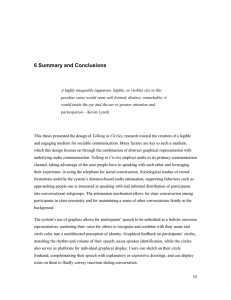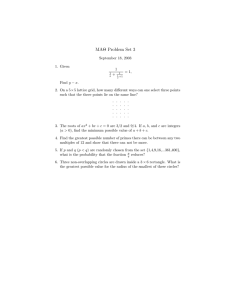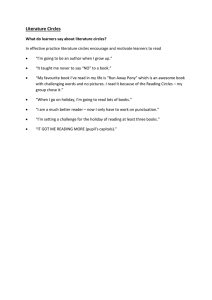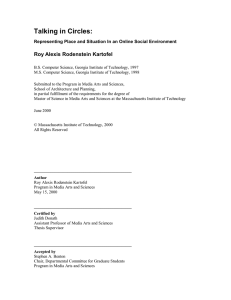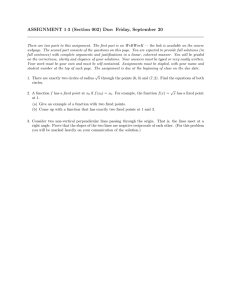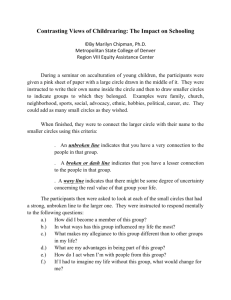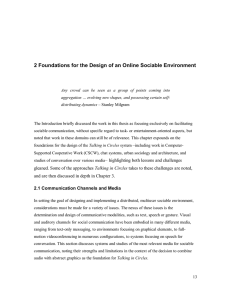1 Introduction – William H. Whyte
advertisement
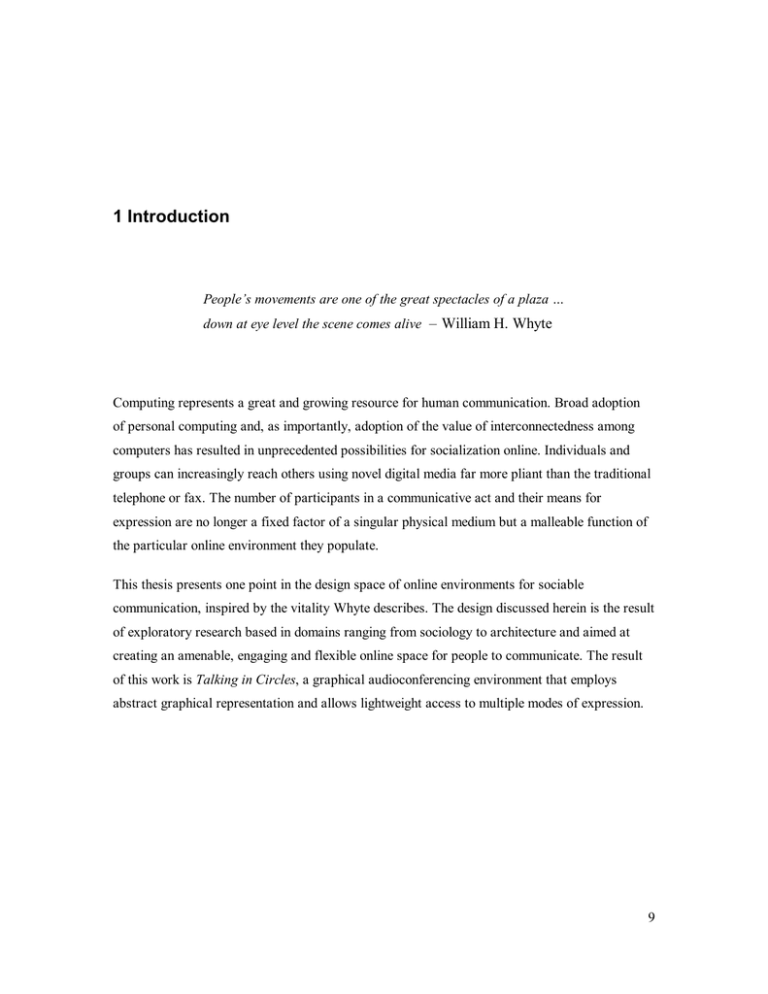
1 Introduction People’s movements are one of the great spectacles of a plaza … down at eye level the scene comes alive – William H. Whyte Computing represents a great and growing resource for human communication. Broad adoption of personal computing and, as importantly, adoption of the value of interconnectedness among computers has resulted in unprecedented possibilities for socialization online. Individuals and groups can increasingly reach others using novel digital media far more pliant than the traditional telephone or fax. The number of participants in a communicative act and their means for expression are no longer a fixed factor of a singular physical medium but a malleable function of the particular online environment they populate. This thesis presents one point in the design space of online environments for sociable communication, inspired by the vitality Whyte describes. The design discussed herein is the result of exploratory research based in domains ranging from sociology to architecture and aimed at creating an amenable, engaging and flexible online space for people to communicate. The result of this work is Talking in Circles, a graphical audioconferencing environment that employs abstract graphical representation and allows lightweight access to multiple modes of expression. 9 1.1 Motivation Recent years have seen an explosion in online communication. While asynchronous media such as electronic mail and USENET news continue to thrive, synchronous communication has emerged with vast popularity. Purely textual exchanges via Internet Relay Chat (IRC) and Multiuser Dungeons (MUDs) as well as chat rooms on the World Wide Web have become common avenues for group discussions and socialization, and environments with strong graphical components, such as The Palace1, are now commonplace. While much work has been done on task- and entertainment-oriented communicative systems, there remains a great need for research on the sociable aspects of online communication, the focus of this thesis work. There are some notable systems that strive to support socialization. IBM’s Babble [Erickson 1999-S], for example, is a graphical chat environment that gives participants a notion of others’ interest in various conversations. Its focus generally remains on work, however; for example, discussions are segregated by named topic and participants are channeled into isolated rooms based on the discussion they explicitly choose to join. Work in rich media such as video spaces has also enhanced possibilities for social communication, due to video’s ability to display gestures and facial expressions, but has similarly focused largely on office settings and a set of participants that share at least some pre-existing affiliation [Fish 1992, Gaver 1992]. In recent years, non-task-oriented approaches to online socialization have mushroomed. Systems emphasizing the use of graphics for entertaining discussions, such as Virtual Places2 and Microsoft V-Chat3, afford the use of interesting graphical avatars for participants’representations. These avatars tend to be broadly caricatured, which can have a great (sometimes) unintended impact on interpretation of the caricature’s messages [Donath 1999]. Further, participants often take advantage of the ability to switch avatars [Smith 2000] which does not necessarily help others maintain a consistent social grasp of them. 1 http://www.thepalace.com 2 http://www.vplaces.net 3 http://vchat.microsoft.com 10 Though these systems collectively address certain issues relevant to sociable communication, they largely regard socialization as a means to an end, whether that end be entertainment or productive work. This thesis treats sociable communication as the primary goal, with sustained, lively and flexible discussion central objectives without regard to secondary ends. Important challenges exist for such a system, such as questions about the representation of the online environment and its participants to create a legible social space. 1.2 System Overview Talking in Circles, extending the design of the Sociable Media Group’s Chat Circles graphical chat environment [Viegas 1999], addresses these challenges through the combination of graphics with audio for communication. Participants in a Talking in Circles session are represented as circles of various colors within a space and can move around this space and speak with each other via a microphone attached to their computer. They can also draw on their circle and use icons for reactive expression (see Figure 1.1). These capabilities, among others, are designed to allow for variety in communication and the ability to navigate the social space of participants. 1.3 Organization of this Document This thesis discusses the design and implementation processes of Talking in Circles as well as experiences with the system. Chapter 2 first sets the background through an elaboration of the foundations of this work in areas such as media spaces and urban architecture. Chapter 3 then describes in full the design of the system, detailing the various aspects and their rationale as based on relevant studies and related research. The implementation, including iterations and refinements, is covered in Chapter 4. Chapter 5 notes a range of user experiences in freeform use of the system, followed by general discussion and conclusions in Chapter 6. Finally, Chapter 7 illustrates potentially fruitful directions for extensions of this work.. 11 Figure 1.1 Six participants conversing in Talking in Circles 12
